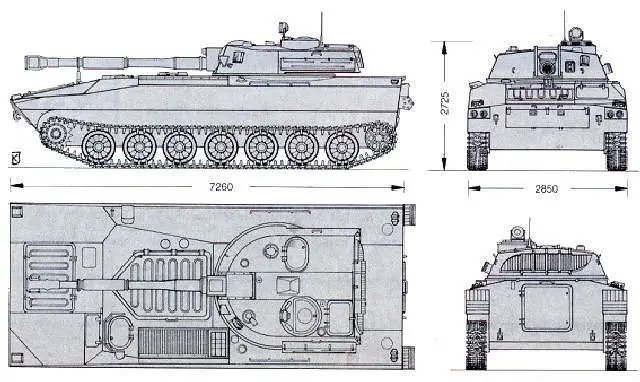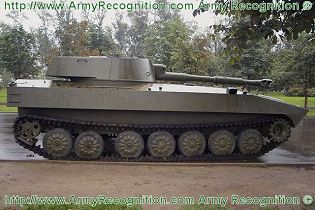- Army
- Air Defense Systems
- Anti-tank systems and vehicles
- Armored Vehicles
- Armoured personnel carriers
- Artillery Vehicles and Weapons
- Command Post
- Communication Vehicles and Systems
- Electronic Warfare
- Engineer | Maintenance Vehicles
- Infantry Fighting Vehicles
- Main Battle Tanks
- Missiles
- Tactical and Logistic Vehicles
- Radars
- Unmanned Systems
- Weapons
- Navy
- Air
2S1 Gvozdika
2S1 Gvozdika
122mm self-propelled howitzer on tracked armored chassis - Russia

Description
The 2S1 Gvozdika is a Russian-made 122mm self-propelled howitzer based on a tracked armored vehicle. The first prototype was ready in 1969. The 2S1 entered service with the Soviet Army in the early 1970s and was first seen in public at a Polish Army parade in 1974. The 2S1 Gvosdika has a crew of four soldiers, including a commander, gunner, loader, and driver. The 2S1 is always used by many armed forces around the world but in the Russian army is only in service with reserve units, and was replaced by the 2S19.
2S1 Gvozdika variants:
- The chassis of 2S1 is used for other Russian-made combat vehicles.
Technical Data
| Armament |
|
The 2S1 is armed with a modified version of the 2A31 cannon which is also fitted to the D-30 towed howitzer. The 122 mm cannon is fitted with a fume extractor and muzzle brake and is held in position, when traveling, by a lock on the hull glacis plate which is operated by remote control by the driver. The Gvosdika is compatible with all 122-mm munitions developed for the D-30 howitzer. These include fragmentation, HE-FRAG, HEAT, cluster, smoke, and illumination projectiles. A total of 40 rounds are carried, usually 35 HE-FRAG and 5 HEAT. The main gun has a maximum firing range of 15.2 km using HE-FRAG (High Explosive Fragmentation) projectiles.
|
| Design and protection |
|
The all-welded steel hull of the 2S1 is divided into three compartments with the driver's at the front on the left, the engine behind the driver,, and the turret at the rear. The all-welded steel armor of 2S1 provides protection for the crew against small arms fire and shell splinters.
|
| Mobility |
| The suspension system of the 2S1 Gvozdika is similar to the MT-LB multipurpose tracked vehicle and either side consists of seven road wheels with the drive sprocket at the front, idler at the rear, and no track-return rollers. An unusual feature of the M-1974 is that the suspension can be adjusted to give different heights, which is of particular use when the vehicle is being transported by tactical transport aircraft. The 2S1 is powered by YaMZ-238N, V-8 water-cooled 4-stroke diesel developing 300 hp which is installed at the front of the chassis. |
| Accessories |
| The 2S1 is fully amphibious, being propelled in the water by its tracks at a maximum speed of 4.5 km/h. Before entering the water the bilge pump is switched on, the trim vane is erected at the front of the hull, shrouds are fitted to the hull above the drive sprocket and front roadwheels and water deflectors on the rear track covers are lowered. Any water that enters the hull during amphibious operations is removed via the exhaust outlet using the bilge pump. while afloat only 30 rounds (projectiles and charges) are carried. Covers are also fitted around the engine air intakes to prevent water ingestion into the engine compartment. Russian sources state that the 2S1 takes 20 minutes to be prepared for amphibious operations. Standard equipment includes infra-red night vision lights and an NBC system. |
Specifications
| Armament | Armor |
| One 122mm 2A31 howitzer | Protection against the firing of small arms and artillery shell splinters. |
| Country users | Weight |
| Algeria, Angola, Armenia, Azerbaijan, Bosnia and Herzegovina, Belarus, Bulgaria, Cuba, Croatia, Eritrea, Ethiopia, Finland, Georgia, India, Iran, Iraq, Kazakhstan, Libya, Poland, South Ossetia, Serbia, Slovakia, Syria, Russia, Ukraine, Uruguay, Uzbekistan, Vietnam, Yemen, Zimbabwe. | 15,700 kg |
| Designer Country | Speed |
| Russia | 62 km/h maximum road speed, 4.5 km/h on water |
| Accessories | Range |
| Infrared night vision, NBC protection system. | 500 km |
| Crew | Dimensions |
| 4 | Length: 7.26 m; Width: 2.85 m; Height: 2.73 m |
Details View
 |
|
 |
 |
 |
 |
Pictures - Video



























